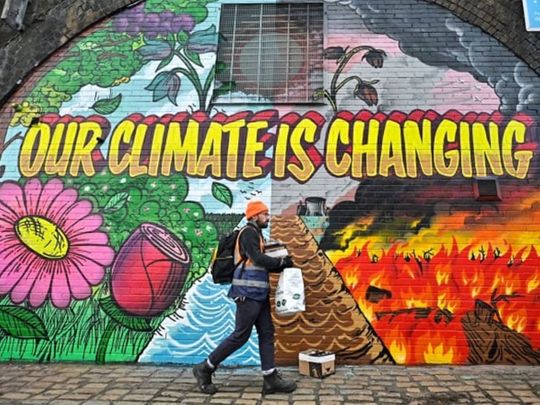
At the recent COP26 in Glasgow, our visionary Prime Minister Narendra Modi continued the tradition of India leading the developing world’s climate change efforts by committing bold reforms in the form of five key deliverables.
- India will increase its non-fossil energy capacity to 500 GW by 2030.
- India will meet 50 per cent of its energy requirements from renewable energy by 2030.
- India will reduce total projected carbon emissions by 1 billion tonnes from now onwards till 2030.
- India will reduce the carbon intensity of its economy by less than 45 per cent by 2030.
- And India will achieve ‘Net Zero’ by 2070.
Attaining these stretch targets will not be an easy task by any means of imagination, but as with COP21, India has proven to the world that it can walk the talk by making fast and meaningful progress on its commitments.
Post the Paris Climate Change agreement, India co-founded the International Solar Alliance, and has already achieved 100 GW out of its 450 GW target from renewable energy by 2030. Today, India boasts of the fourth highest installed renewable energy capacity in the world and our non-fossil fuel energy generation has grown by 25 per cent in the past seven years to 40 per cent of our net energy basket today.
India’s Father of the Nation Mahatma Gandhi once said, “In a gentle way, you can shake the world”. Prime Minister Modi lives by this adage. And the above commitments are a testimony to that.
I want to highlight the fact that we have managed to fulfil our promises while concurrently achieving a rate of growth in energy consumption - rarely seen anywhere else in the world.
A win-win for all
India’s energy consumption doubled from about 300 MToE (million tonnes of oil equivalent) in 2000 to over 600 MToE in 2020. India’s energy demand is expected to grow at about 3 per cent per annum till 2040, compared to the global average of 1 per cent, as India’s share in global energy demand doubles to 11 per cent.
What is truly remarkable is that despite having 17 per cent of the world’s population, we only account 5 per cent of global emissions. India, despite being in a position to maximize utilization of fossil fuels for her growing energy needs, showcased her ethics of Vasudhaiva Kutumbakam, which means ‘the world is one family’ in Sanskrit, by responsibly investing rapidly increasing the share of renewable energy and driving down GHG emissions.
It is distressing to see reluctance among oil producing countries in supporting India’s efforts for clean energy. The reduced supply of petroleum in the international market has driven prices as high as $82 a barrel for Brent crude and $4.95 a MMBtu for natural gas - the highest prices since 2014 and 2010, respectively, and the sharpest price-rise in recent history.
The Asian Premium is another anomaly, against which we have been appealing. As the fastest growing Energy market, Asia deserves a dividend and not be paying a premium.
Eating into India’s prospects
The high prices of raw energy adversely affect developmental imperatives of welfare economies like India. In the days leading up to COP26, the Indian central and a number of state governments were compelled to reduce taxes and levies to protect our price-sensitive citizens from high inflationary pressure, especially in the run up to the festival of Diwali.
It must be noted that such forced fiscal measures compromise our ability to invest in clean energy for meeting the needs of 1.4 billion citizens and also setback India’s efforts for developing new renewable energy technologies such as Green Hydrogen.
Full backing
As one of the fastest growing global economies (our GDP is expected to grow at a rate north of 9 per cent in FY2021-22) India represents one of the largest energy markets in the world for oil producing nations. We have rolled out a series of facilitative reforms in the exploration and production (E&P) sector for increasing the net geographical area under exploration from 8 per cent (0.25 million square kilometres) to 15 per cent (0.5 million square kilometres) by 2025 and are expecting an investment of $58 billion in E&P by 2023.
Energy independence is high on my Government’s agenda.
We are rapidly ramping up the share of natural gas in our energy mix from the present 7 per cent to 15, and expecting an investment of $60 billion by 2024. We recently invited City Gas Distribution (CGD) bids for 65 Geographical Areas, post which 86 per cent of India’s geographical area and 96 per cent of its population will be covered under CGD. We are keen on collaborating with natural gas suppliers for long-term contracts at preferential prices.
Let’s hear ourselves out
To my dear friends in the UAE and other oil producing countries, I say: Our nations share a long history and have worked together extensively for co-prosperity of our people. We stand at a critical juncture in human history, when the world is at the cusp of recovering from a global pandemic of unprecedented scale.
This fragile global economic recovery, which will set the pace for decades to come, is highly susceptible to the constraints placed on the economies of developing nations like India by high energy prices. Developing countries like India are not mere consuming markets where prices can be maximized, but a key stakeholder in the fight against climate change.
We are willing to join hands with all consuming and producing Nations for transparent, just and balanced oil markets with a view to moving ahead in sync with everyone towards the avowed global goal of climate protection.
Sustainable and stable petroleum prices are crucial for supporting the fragile global economic recovery and transition to clean energy. It is time for the oil producers of the world to comprehend the gravity of the situation and ensure energy justice by significantly increasing the supply of petroleum in the market, so that the high energy prices don’t scuttle our collective ambitions for economic growth and resolutions against climate change.









